Your Complete Guide to Chatbot Marketing

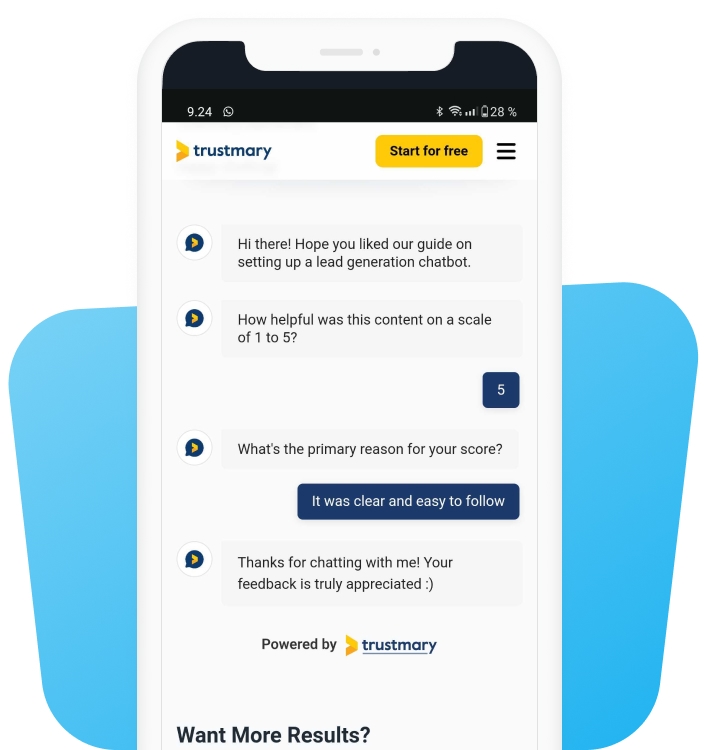
Chatbot marketing is an affordable way to ensure your business has an assistant promoting and selling your products around the clock.
This marketing technique uses computer programs called chatbots that have been trained to understand your customers as well as your brand and its product offerings.
Today, businesses can choose between rule-based, manually built chatbots or fully automated AI chatbots. We'll figure out which one suits your needs best.
Chatbots can be extremely effective marketing agents when executed correctly. Data shows that over 50% of businesses using chatbots generate more high-quality leads. Not only that, but businesses with an effective chatbot marketing strategy also enjoy a 67% increase in sales.
What does an effective chatbot marketing strategy look like, though?
In this article, we’ll show you how to build a successful chatbot marketing strategy and share some examples of brands that are already doing it.
But let’s start at the top.
What is Chatbot marketing?
Chatbot marketing is a marketing strategy where brands use automated computer programs (chatbots) to engage users and promote products and services. These chatbots can execute different marketing tasks depending on how they’re programmed.
For example, they can help generate leads, create awareness, and even make personalized product recommendations.
The chatbots used in marketing can be rule-based or powered by AI. Rule-based chatbots follow a predetermined flowchart or script to market your products. The bot may provide several options to prospects, like “learn about our products,” “see pricing”, and “Talk to an agent”. The bot will then guide prospects down a fixed path depending on the user input.
HubSpot uses this kind of chatbot alongside an AI-powered conversational one, i.e., you can follow a fixed path or ask a question.

Rule-based chatbots are the easiest to execute. However, they are limited in that they cannot handle customer queries outside the fixed paths, which is where AI-powered chatbots can be superior.
AI-driven chatbots use machine learning and natural language processing to engage users in conversations. Users can make their inquiries, and the chatbot will analyze the question, understand the context, and use its trained data to provide a relevant response to the users.
Casper uses that chatbot to engage users, as you can see from the window below.
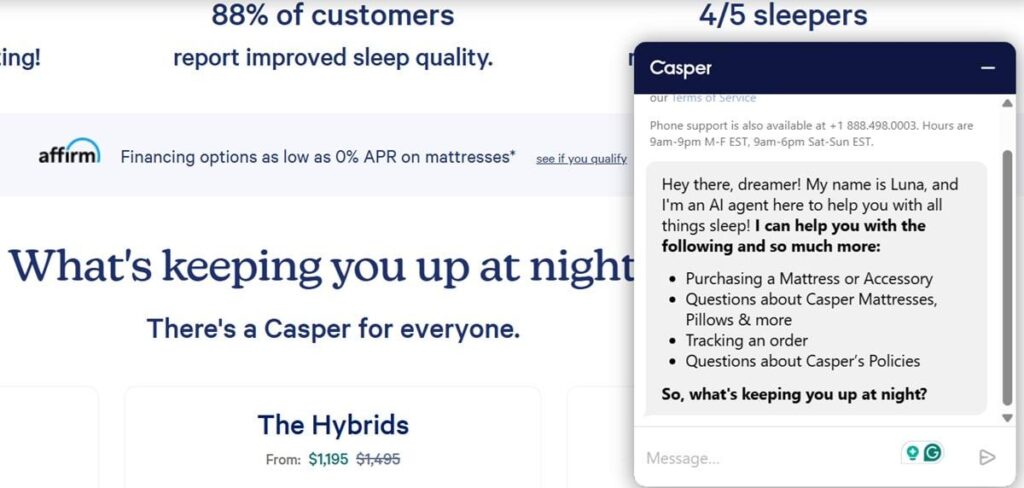
AI-powered chatbots can be vastly superior marketing agents, but they are more resource-intensive to implement compared to rule-based chatbots.
Both types of chatbots can be deployed across various marketing channels. You can include them on your website and use them on Facebook Messenger, Telegram, and WhatsApp. We’ll show you how in a bit.
Which one to choose?
Here is a simple rule of thumb used by teams that follow customer-led growth principles:
Choose an AI chatbot if your visitors’ questions vary widely, and you want to reduce friction by giving tailored, natural responses.
Choose a rule-based chatbot if your funnel is simple, predictable, and relies on guiding people toward a specific action with minimal distraction.
Often, the highest-converting approach is a hybrid: clear button flows for key actions, and AI available for everything else.
Benefits of chatbot marketing
Businesses of all sizes are currently using chatbots for different purposes. About 16% of small businesses, 15% of mid-sized businesses, and 24% of enterprise companies use chatbots for marketing, sales, or customer support.
Here is why these computer programs have become so important to modern businesses.
Prompt response
Speed is so important to modern consumers. In fact, data from the same G2 report above shows that 82% of consumers would rather engage a chatbot than sit around waiting for a representative. This is a 20% increase from 2022.
Chatbots are virtual assistants that don’t need to take a break or vacation. They are available around the clock and have instant access to all the data they need to do their job. That means they provide instant answers to customer queries, and this is essential for ensuring a seamless customer experience.
Can be customized
Chatbot interactions can be customized to deliver personalized experiences. These bots can ask customers specific questions and use the answers to deliver tailored recommendations, for example.
These tailored experiences are essential in keeping the customers engaged. They can also boost conversion rates since they give users relevant recommendations.
Boosts customer engagement
Chatbots are extremely effective at engaging potential customers. These bots can be fun, with some of them using GIFs to engage users.
The conversational nature of chatbots also makes for a more interactive experience, where users can go back and forth discussing their options with the bots. This creates a stronger connection with prospects and helps move them down your sales funnel.
Multichannel capability
Another benefit of chatbot marketing is that you can deploy it across multiple channels. This is extremely important because you need to be everywhere your target audience is to reinforce your brand’s offerings.
You can deploy chatbots on your website, Facebook Messenger, WhatsApp, and Telegram. You can even use bots to engage customers via SMS.
A great chatbot marketing strategy will also help you deliver a consistent brand experience across all channels. This boosts brand trust, which enables you to convert prospects and build a loyal customer base.
Data collection and analysis
Chatbot marketing helps you collect valuable consumer data. For starters, you can use them to build an email list by capturing the users’ names and email addresses. Just make sure you integrate it with a CRM or an email automation platform like GetResponse to transfer the leads automatically.
Beyond that, you can use these bots to collect data on what customers are looking for. This is especially the case with conversational chatbots. These bots can engage users in a dialogue and capture data on customer pain points and preferences.
The insights will be useful in enhancing your overall marketing strategy and product messaging. Moreover, they can uncover product improvement opportunities to help you better serve your customers.
And it’s not just about marketing. These chatbots can also help you collect customer feedback. This can help you understand how customers use your products, the bottlenecks they encounter, what they love about your brand, and so on. Such insights are instrumental to your brand’s long-term success.
Lead segmentation, qualification, and nurturing
Chatbots can engage users to identify what products they’re interested in and how far they are in the customer journey.
Say you have a dropshipping business selling various beauty products. If the customer asks several questions related to a particular product line, e.g., skincare, the bot can immediately place the user in a relevant segment and target them with the right messaging and product recommendations.
Similarly, if a user is interested in pricing details and money-back guarantees, the chatbot can determine that the lead is warm and possibly ready to either make a purchase or talk to a salesperson.
You should also know that a well-programmed chatbot can support your lead-nurturing efforts. Depending on what the user has shown interest in, the bot can provide helpful insights and suggest educational resources. 1-800 Flowers’ conversational chatbot does this quite well.
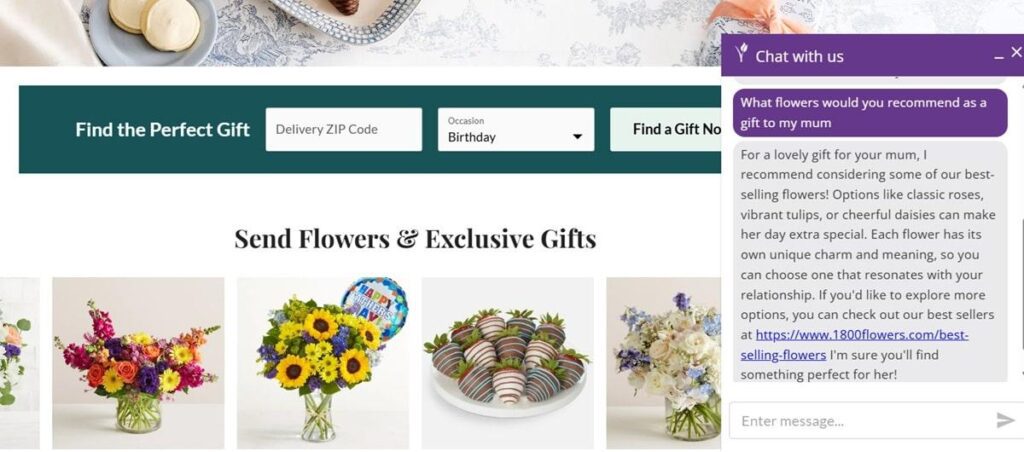
All these activities reduce the workload on your marketing and sales teams. Your marketing team can spend more time on strategic tasks while SDRs engage sales-ready prospects and close more deals.
How to create a chatbot marketing strategy
Here is a 5-step guide to help you build a successful chatbot marketing strategy.
1. Set a clear objective
A great chatbot marketing strategy starts with a clear objective or goal. What exactly do you hope to achieve by deploying the chatbot?
Remember that chatbots can be used to support different marketing activities. You could use them for lead generation, building brand awareness, nurturing leads, or selling your products.
Determining the specific objective behind your chatbot strategy sets the foundation for everything else. So, for example, if the goal is to generate leads, then you’ll know the path the chatbot strategy should take. For starters, it’ll need a way to capture email addresses, similar to what HubSpot’s HubBot does below.

At the same time, a clear goal or objective makes it easier for you to know what success looks like. So you’ll know what metrics to keep an eye on to determine whether your chatbot marketing investment produces meaningful ROI.
In the case of a lead generation chatbot, you’ll monitor the number and quality of leads coming through your chatbot.
So, define a clear objective you want to achieve with your chatbot. Next, identify the key performance indicators you can use to measure your chatbot's performance in achieving that objective.
Then move to the next step…
2. Choose your marketing channels
Where do you want to deploy your chatbot? That’s the next question you’ll need to answer.
The platform you pick will determine the type of chatbot you need. Some chatbots are exclusively built to be deployed on a website. Others work better on messaging apps and social platforms like WhatsApp, Telegram, and Facebook Messenger.
Therefore, start by pinpointing the platforms on which you need to deploy the chatbots. That involves analyzing your goal and your target audience to determine where they hang out.
So, which platform is popular among your target audience that can help you achieve the specific marketing objectives you have in mind? Go through your buyer persona (if you have one) or do audience research to get the answer to this question.
3. Choose a chatbot provider
At this point, you should have a clear understanding of what you want to achieve with your chatbot marketing strategy and the platform on which to execute your strategy. So, the next step is finding a chatbot provider that aligns with your needs.
The good news is that there is no shortage of chatbot builders. Also, chatbot builders have advanced to become easy-to-use platforms you can use to create effective bots without any coding.
For example, Trustmary provides an incredible rule-based chatbot for lead generation. The chatbot can display customers’ reviews to build trust and capture their contact information.
Trustmary’s platform lets you deploy a pop-up or in-page chatbot. They also have a variety of templates to pick from, so you don’t have to build the bot from scratch. More importantly, the platform lets you customize the chatbot so you can give it some personality and ensure it aligns with your branding style. More on this below.
That said, your options are not limited to a chatbot platform. You can create a custom chatbot from scratch. However, this is likely to be very resource-intensive, so it’s a viable option for businesses with a bigger budget.
4. Match chatbot personality with your brand
The chatbot should reflect your overall brand personality.
Do all your marketing assets have a witty and fun personality? The same should be felt when someone interacts with the chatbot.
Therefore, take your time to customize the chatbot and ensure it's consistent with your overall branding style. You can start by giving it a fitting name and profile picture.
Next, customize the conversations and responses from the chatbot to reflect the rest of your content style.
Once you’re done, test the chatbot to ensure everything works as it should.
5. Deploy and track performance
Finally, deploy your chatbot, then track user interactions and feedback. Have users reported any new issues or opportunities for improvement? Look into those recommendations and adopt the changes that can enhance the user experience and help you achieve your goals.
Speaking of goals, keep an eye on how the chatbot strategy is helping you achieve the objectives you set in step one above. Also, A/B test different chatbot paths and the content to optimize their performance.
Examples of chatbot marketing
Here are two of our favorite chatbot marketing strategies:
Example 1: Procosmet
Procosmet is an Italian brand that uses a rule-based chatbot for marketing. The chatbot initiates the conversation with a 10% discount offer to users who sign up for the company’s newsletter. This is a clever lead generation strategy.

The bot also educates users about the brand’s product offerings.
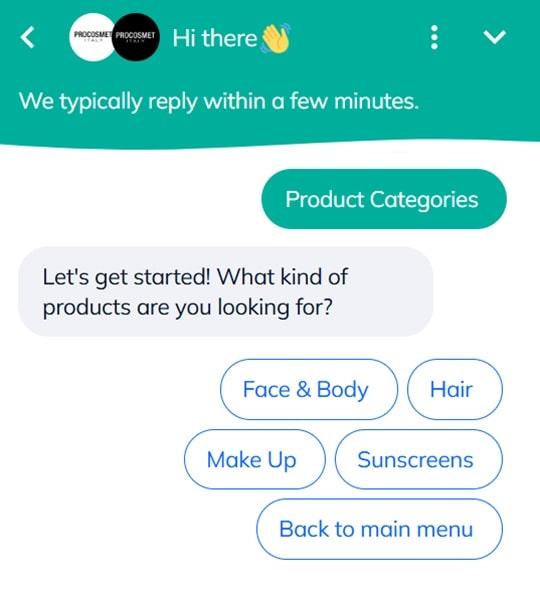
Besides marketing the brand, Procosmet’s chatbot helps with customer support, tracking orders, and providing refunds and returns details.
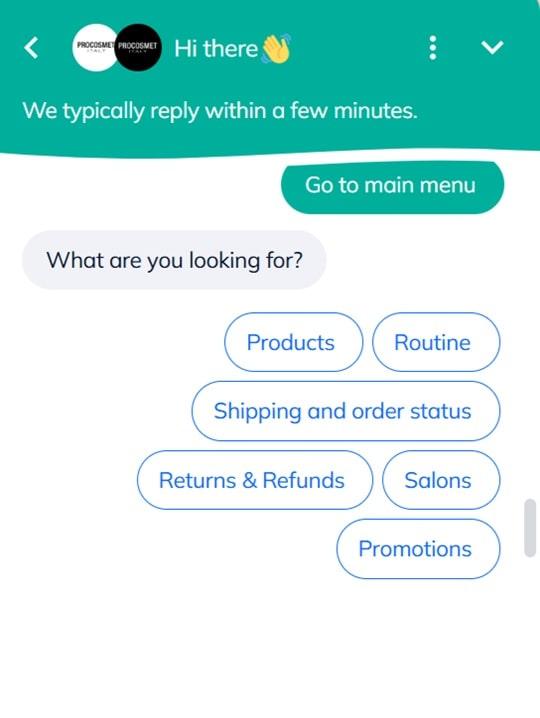
The only possible improvement that could be made to that chatbot is giving it a bit more personality.
Example 2: Casper
Casper has a pretty effective chatbot marketing strategy powered by an AI bot. First off, the chatbot has a casual and cheerful personality, which makes it more engaging. Check out this intro.
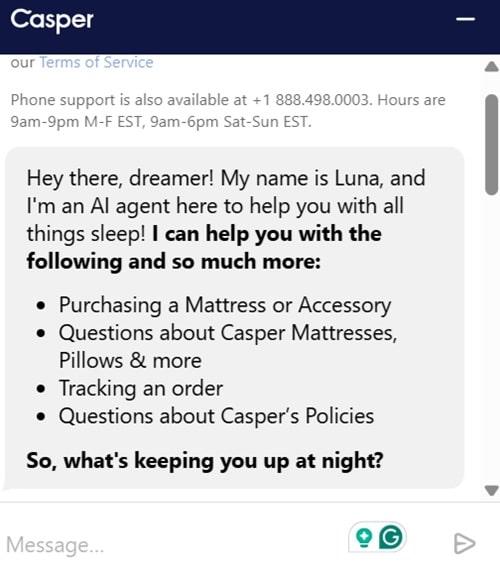
The chatbot helps with building awareness about their product offerings.
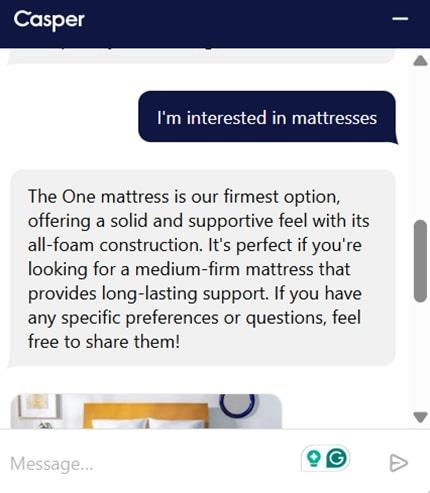
Even more interestingly, it allows users to add products to the cart directly from the chat.
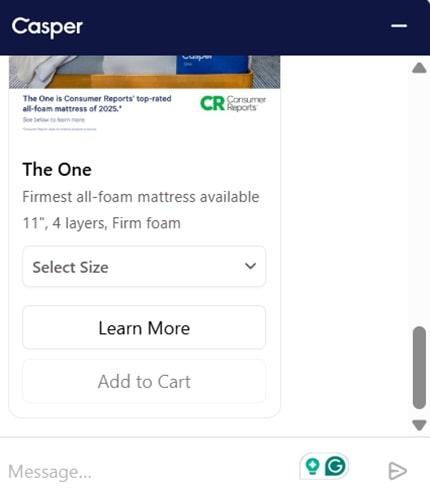
Potential customers can learn more about the product, select the appropriate size, and add it to the cart conveniently.
Chatbot marketing mistakes to avoid
Here are three common pitfalls you’ll want to avoid to ensure your chatbot marketing strategy remains on point:
- Don’t overuse on visitors – Chatbots are great, but they shouldn’t be the only thing potential customers interact with when they engage your brand.
A personal touch from a human is still very vital. Therefore, make sure your chatbot strategy provides a path for users to contact a human.
- Don’t leave your chatbot unmonitored – Your chatbot marketing strategy should change with the evolving customer needs and trends.
So, monitor your chatbot regularly to ensure it still aligns with customer expectations. This is the only way to deliver a pleasant customer experience at all times and achieve your marketing objectives.
- Over-triggering and poor timing – A poorly executed chatbot strategy can create a frustrating user experience. Can you imagine how you would feel if a chatbot filled your entire screen, or got triggered every time you reloaded a page or visited a new page? This would be very frustrating.
So, make sure the chatbot is triggered at the right time and is not too pushy. You can set a delay for the chatbot to be triggered a few moments after the user has landed on your website, for example. The cancel option should also be clearly visible.
In closing
Chatbot marketing is a great way to ensure customers can learn more about your brand and continue shopping even when your team is offline. The rise of AI solutions has also made them even more accessible.
Follow the 5-step guide above to ensure your chatbot actually supports your company’s bottom line.
Check out Trustmary’s chatbot here to see how they can help promote your products and capture contact information of your potential customers.
Written in collaboration with Michal Leszczynski, Head of Content Marketing and Partnerships at GetResponse.